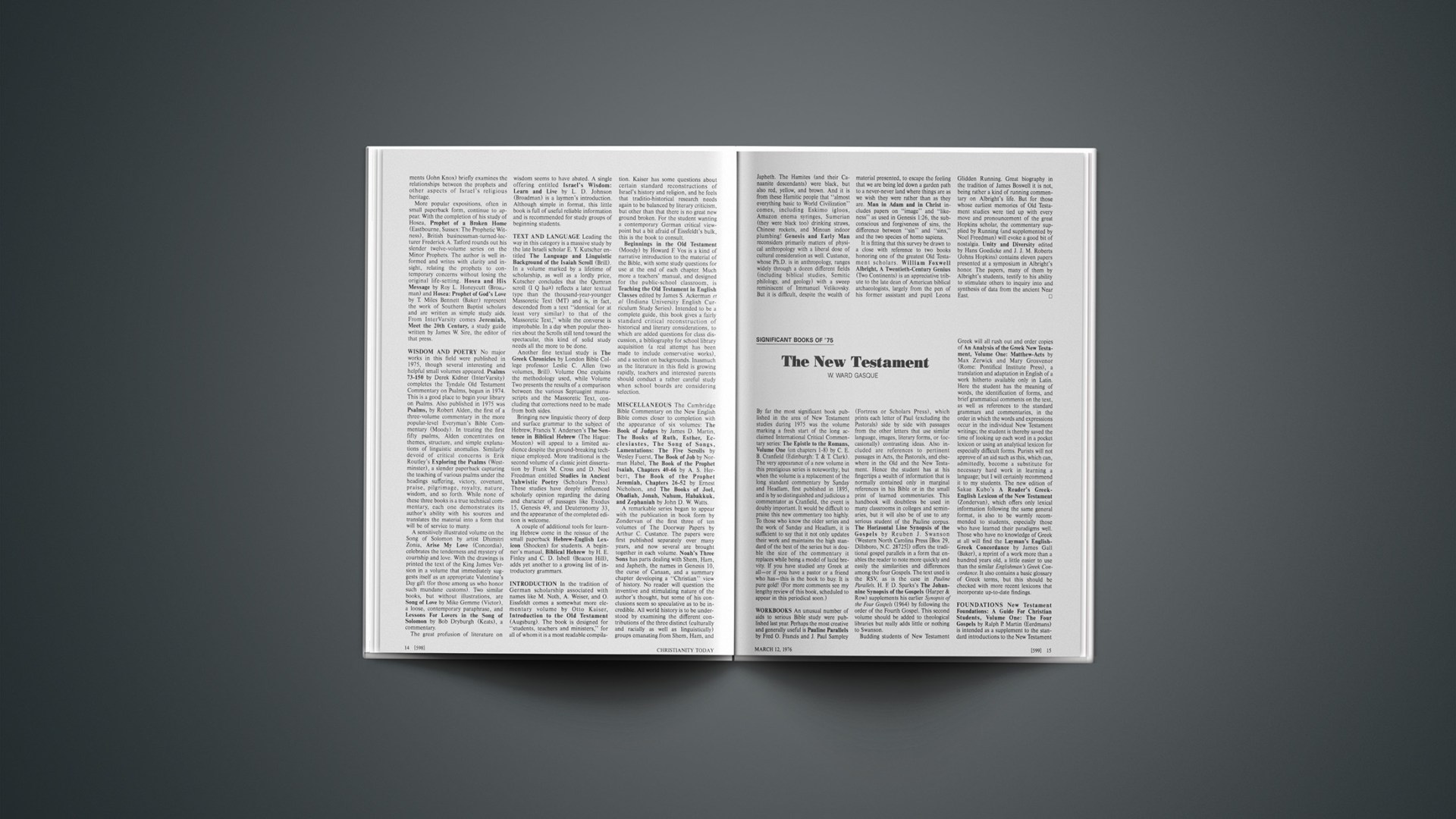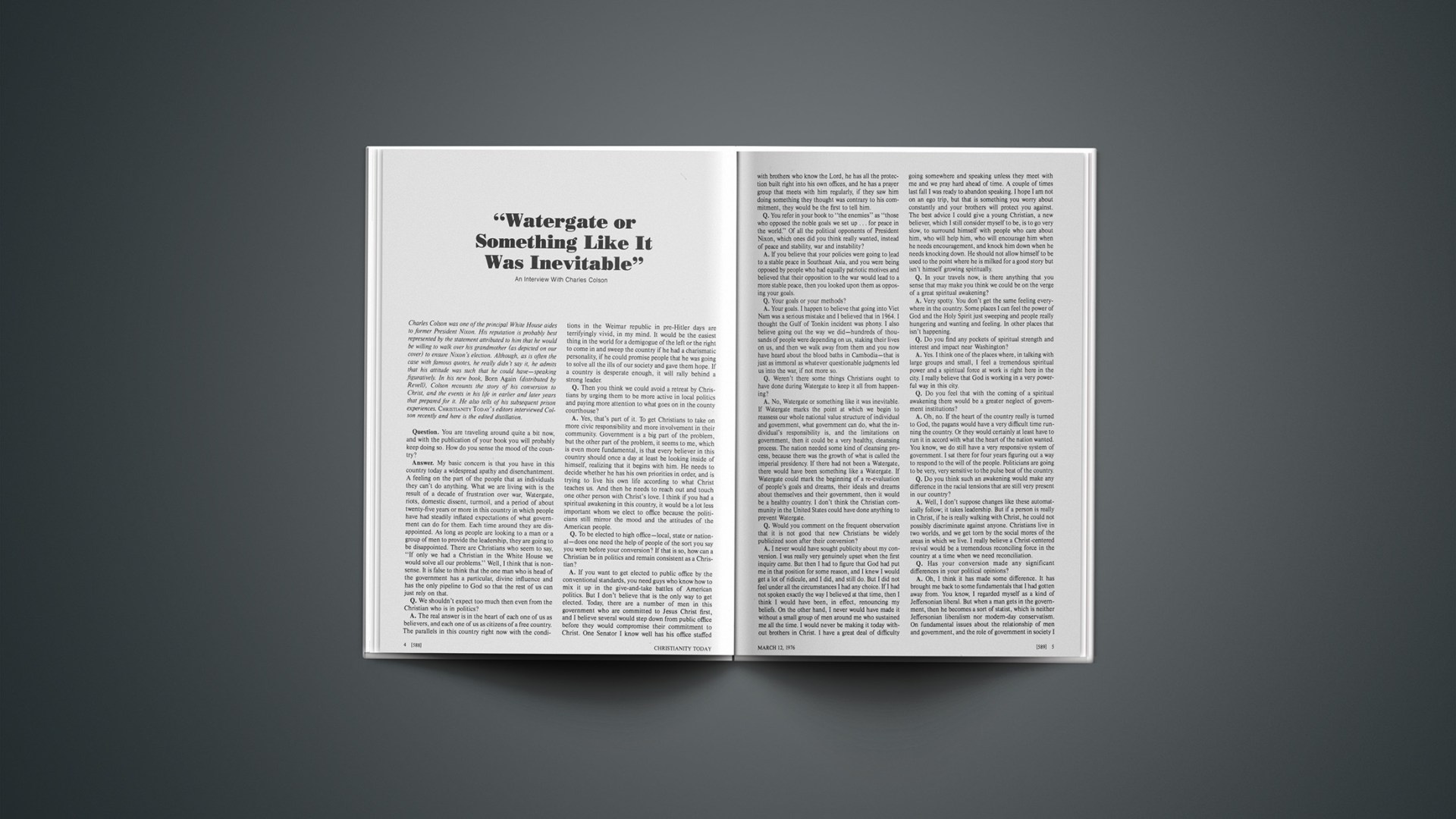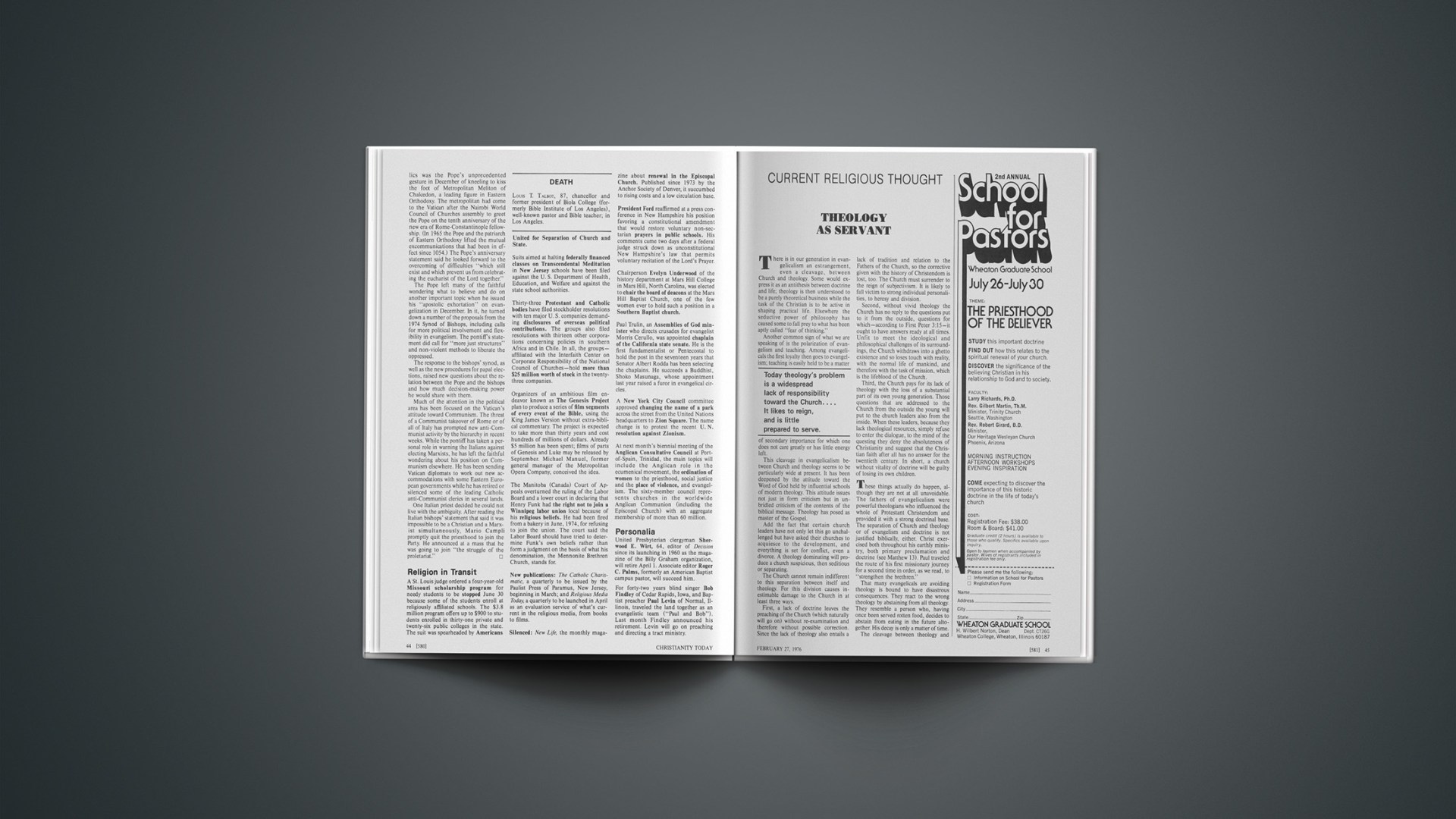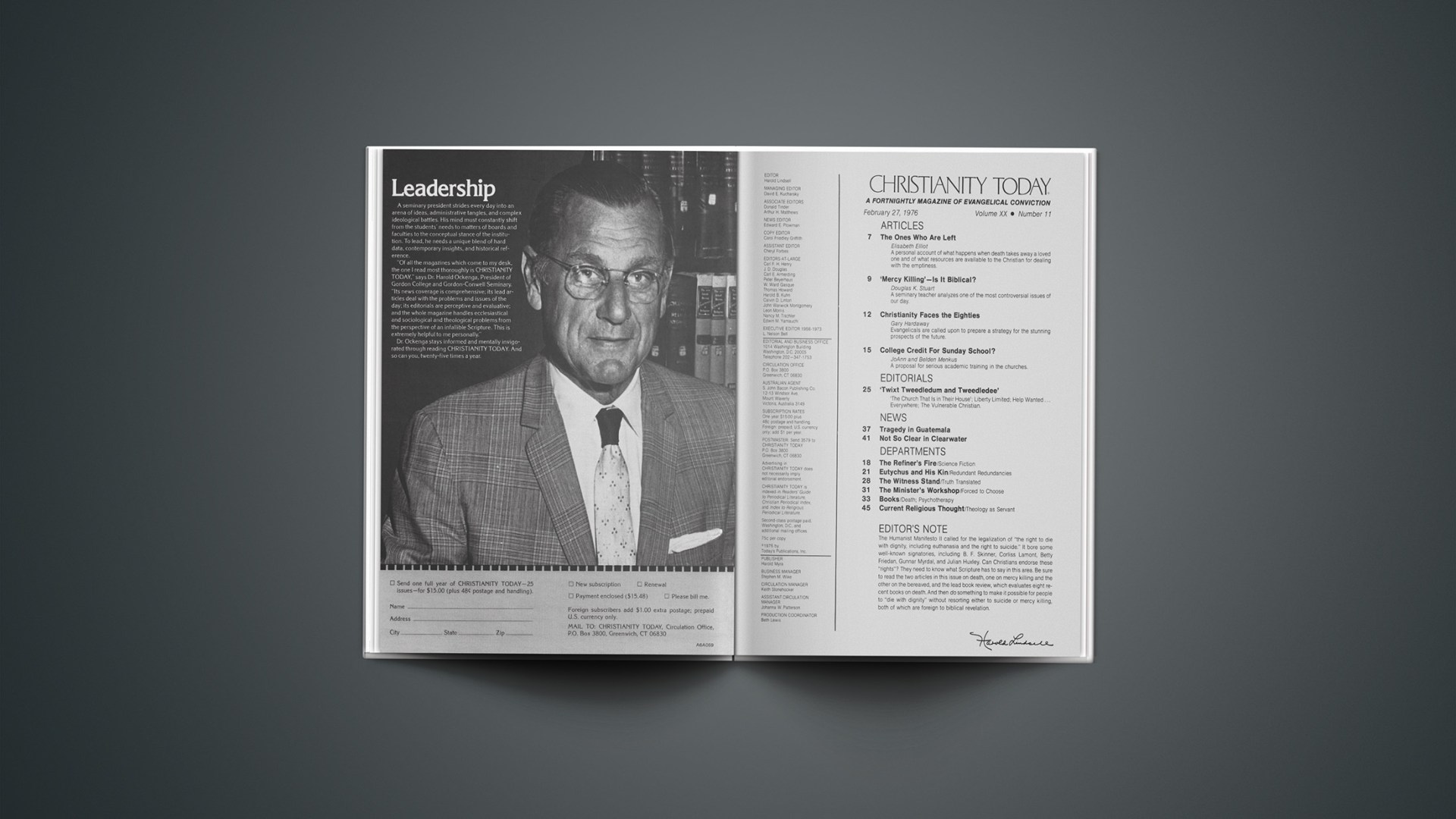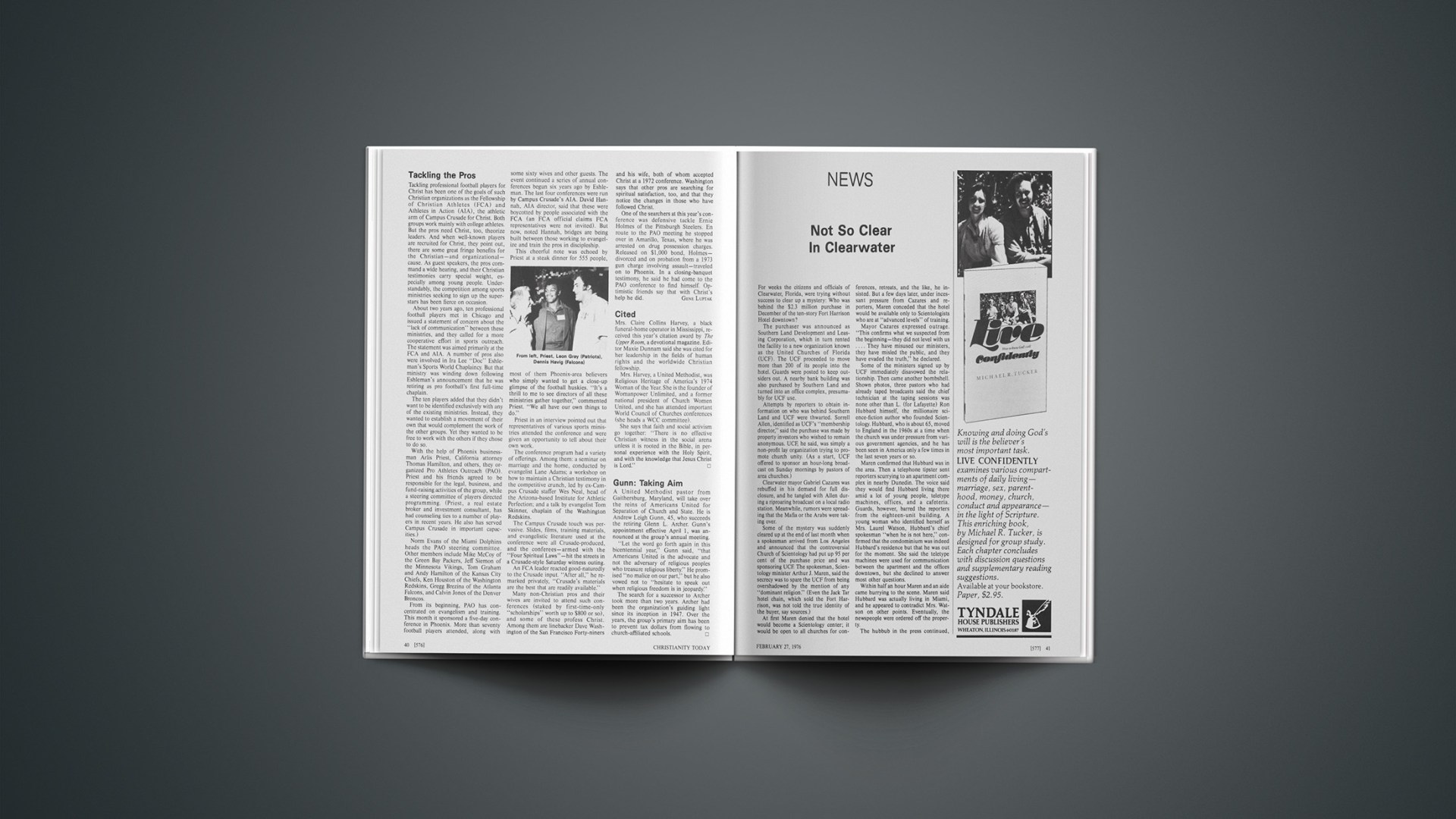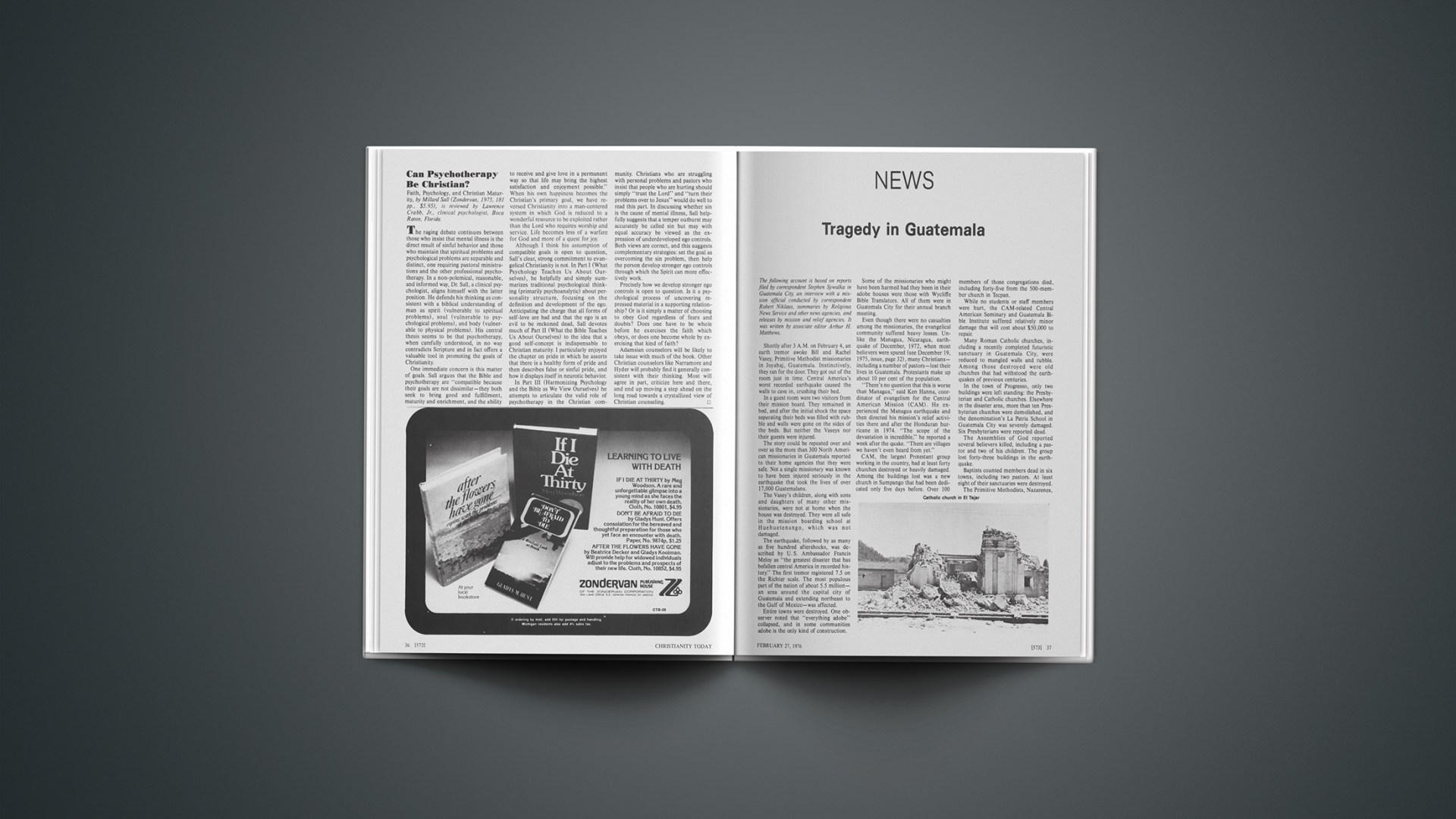By far the most significant book published in the area of New Testament studies during 1975 was the volume marking a fresh start of the long acclaimed International Critical Commentary series: The Epistle to the Romans, Volume One (on chapters 1–8) by C. E. B. Cranfield (Edinburgh: T. & T. Clark). The very appearance of a new volume in this prestigious series is noteworthy; but when the volume is a replacement of the long standard commentary by Sanday and Headlam, first published in 1895, and is by so distinguished and judicious a commentator as Cranfield, the event is doubly important. It would be difficult to praise this new commentary too highly. To those who know the older series and the work of Sanday and Headlam, it is sufficient to say that it not only updates their work and maintains the high standard of the best of the series but is double the size of the commentary it replaces while being a model of lucid brevity. If you have studied any Greek at all—or if you have a pastor or a friend who has—this is the book to buy. It is pure gold! (For more comments see my lengthy review of this book, scheduled to appear in this periodical soon.)
WORKBOOKS An unusual number of aids to serious Bible study were published last year. Perhaps the most creative and generally useful is Pauline Parallels by Fred O. Francis and J. Paul Sampley (Fortress or Scholars Press), which prints each letter of Paul (excluding the Pastorals) side by side with passages from the other letters that use similar language, images, literary forms, or (occasionally) contrasting ideas. Also included are references to pertinent passages in Acts, the Pastorals, and elsewhere in the Old and the New Testament. Hence the student has at his fingertips a wealth of information that is normally contained only in marginal references in his Bible or in the small print of learned commentaries. This handbook will doubtless be used in many classrooms in colleges and seminaries, but it will also be of use to any serious student of the Pauline corpus. The Horizontal Line Synopsis of the Gospels by Reuben J. Swanson (Western North Carolina Press [Box 29, Dillsboro, N.C. 28725]) offers the traditional gospel parallels in a form that enables the reader to note more quickly and easily the similarities and differences among the four Gospels. The text used is the RSV, as is the case in Pauline Parallels. H. E. D. Sparks’s The Johannine Synopsis of the Gospels (Harper & Row) supplements his earlier Synopsis of the Four Gospels (1964) by following the order of the Fourth Gospel. This second volume should be added to theological libraries but really adds little or nothing to Swanson.
Budding students of New Testament Greek will all rush out and order copies of An Analysis of the Greek New Testament, Volume One: Matthew-Acts by Max Zerwick and Mary Grosvenor (Rome: Pontifical Institute Press), a translation and adaptation in English of a work hitherto available only in Latin. Here the student has the meaning of words, the identification of forms, and brief grammatical comments on the text, as well as references to the standard grammars and commentaries, in the order in which the words and expressions occur in the individual New Testament writings; the student is thereby saved the time of looking up each word in a pocket lexicon or using an analytical lexicon for especially difficult forms. Purists will not approve of an aid such as this, which can, admittedly, become a substitute for necessary hard work in learning a language; but I will certainly recommend it to my students. The new edition of Sakae Kubo’s A Reader’s Greek-English Lexicon of the New Testament (Zondervan), which offers only lexical information following the same general format, is also to be warmly recommended to students, especially those who have learned their paradigms well. Those who have no knowledge of Greek at all will find the Layman’s English-Greek Concordance by James Gall (Baker), a reprint of a work more than a hundred years old, a little easier to use than the similar Englishman’s Greek Concordance. It also contains a basic glossary of Greek terms, but this should be checked with more recent lexicons that incorporate up-to-date findings.
FOUNDATIONS New Testament Foundations: A Guide For Christian Students, Volume One: The Four Gospels by Ralph P. Martin (Eerdmans) is intended as a supplement to the standard introductions to the New Testament by Guthrie and Kummel. With an emphasis upon recent scholarship, it deals with the literary form “gospel” and with trends of current study. It presents historical and literary background of the New Testament period and gives a brief introduction to each Gospel, emphasizing its theology. Already known for two volumes of introduction to the epistles, Mennonite scholar D. Edmond Hiebert now contributes An Introduction to the New Testament, Volume One: The Gospels and Acts (Moody).
Of interest to the more advanced student will be Charles Talbert’s Literary Patterns, Theological Themes, and the Genre of Luke-Acts (Scholars Press), which traces suggested parallels between and within Luke and Acts, significant theological motifs, possible literary models from the Greco-Roman world, and the like. Not least of the valuable features of this important monograph is the low price, typical of books published by Scholars Press! A work that complements the material contained in Talbert’s work is my own A History of the Criticism of the Acts of the Apostles (Eerdmans). Suffice it to say that the book has been gratifyingly commended by reputable scholars.
A helpful guide to interpretive principles influencing the New Testament authors in their handling of the Old Testament and also Jewish hermeneutics of the same period is Richard Longenecker’s latest work Biblical Exegesis in the Apostolic Period (Eerdmans). Once again Longenecker shows himself to be the master of his materials and leads the way in making an important evangelical contribution to contemporary biblical scholarship. In Kerygma and Comedy in the New Testament (Fortress), Dan O. Via, Jr., employs the literary category of comedy for interpreting death and resurrection in Paul and Mark’s passion narrative.
JESUS AND THE GOSPELS The book in this general category that will have an appeal to almost everybody is Jesus: The Man Who Lives by Malcolm Muggeridge (Harper & Row), though few if any readers will agree with everything he says. Here is a book, beautifully illustrated from classical Christian art and drawing its inspiration from a wide variety of literary sources, in addition to the Gospels, to wake up sleepy believers and to interest men and women outside the faith. Those who have followed the author’s pilgrimage for some years will be glad to see him clearly within the fold. The Child Jesus by Adey Horton (Dial) gathers paintings on the early years with commentary on the influence of non-canonical sources for Christian beliefs in areas where the Gospels say very little.
Of a very different nature and much more technical, but also bound to have a wide appeal because of its subject matter, is Jesus and the Spirit by James D. G. Dunn (Westminster). The author is a Scottish theologian who has specialized in pneumatology for some years. Dunn’s book should be studied by charismatics, anti-charismatics, and simply unhyphenated Christians alike.
Two other books in this area should be of wide general interest, the first of them more popular and the second decidedly technical: The Difficult Sayings of Jesus by William Neil (Eerdmans) and Jesus and the Law in the Synoptic Tradition by Robert Banks (Cambridge). The first is a commentary on some of the more important sayings of our Lord that have been often misunderstood or that seem to be difficult for the ordinary Bible reader to understand; one hopes the author will issue a sequel, since his selection by no means exhausts the list. Banks’s study, originally a Cambridge doctoral dissertation, is a magnificent work dealing with the problem of “law” vs. “freedom,” authority, and structure in the context of our Lord’s teaching. His work will be important for the area of systematic theology as well as for biblical studies.
Parables Told by Jesus (Alba) is a non-technical introduction to the subject by Wilfrid J. Harrington, a Roman Catholic scholar who has the ability to communicate the results of contemporary research in extremely readable language. Of a more academic orientation is The Parables of the Triple Tradition by Charles E. Carlston (Fortress), which deals with representative parables and will be primarily of interest to teachers and more advanced students. The Jesus of the Parables by Charles W. F. Smith (Pilgrim), first issued in 1948, has now been updated and revised.
Three important works on the Gospel of John appeared last year: The Gospel of John and Judaism by C. K. Barrett (Fortress), presenting reflections of the subject subsequent to his well-known commentary published in 1955; D. George Vanderlip, Christianity According to John (Westminster), an exposition of the author’s conception of the major motifs of the evangelist’s message; and J. Painter, John: Witness and Theologian (London: SPCK), a revision of a doctoral dissertation written under Barrett. On Mark, the professor of New Testament at Strasbourg, Etienne Trocme, has written The Formation of the Gospel According to Mark (Westminster), a discussion of the sources that he thinks the author used in writing his Gospel. And on Matthew, there are The Passion Narrative According to Matthew by Donald P. Senior (Gembloux, Belgium: Editions Duculot, for Leuven University Press), a redactional study by an American Catholic scholar, and Matthew: Structure, Christology, Kingdom by Jack Dean Kingsbury (Fortress).
Focusing on the place of the Lord in the Kerygma is Graham N. Stanton’s Jesus of Nazareth in New Testament Preaching (Cambridge), a Society of New Testament Studies monograph by a younger evangelical scholar. Also beginning with the Gospels but moving quickly into the realms of historical and systematic theology—how else could one write more than 500 pages on the subject?—is The Mother of Jesus in the New Testament by John McHugh (Doubleday), a very learned and orthodox Roman Catholic. Reading this book will be an eye-opener for all Protestants and liberal Roman Catholics. In much smaller compass but of major significance is Der Sohn Gottes by Martin Hengel (Tübingen: J. C. B. Mohr), an attempt to show that the title “Son of God” applied to Jesus by Paul had its origin in a Jewish context, not in a pagan-hellenistic one, as some scholars have alleged. Ordinary Christians have always supposed this, but it is nice to hear it from the lips of a famous German scholar! Finally, a work written in honor of Hans Conzelmann of Gottingen, that contains essays in French, English, and German is Jesus Christus in Historie und Theologie edited by Gerhard Strecker (J. C. B. Mohr); among others, the essay by E. Earle Ellis, “New Directions in Form Criticism,” which challenges some of the major assumptions of contemporary scholarship, will be of broad general interest. Advanced students will also want to consult Resurrection and the Message of Easter by Xavier Leon-Dufour (Holt, Rinehart and Winston).
PAUL Last year brought a harvest of good books on Pauline theology. One of the finest was the translation of Dutch theologian Hermann Ridderbos’s Paul: An Outline of His Theology (Eerdmans), which is bound to be a standard textbook, in conservative circles at least, for many years to come. Other important contributions to the understanding of Paul’s theology include Paul and the Anatomy of Apostolic Authority by John Howard Schutz (Cambridge), who combines New Testament exegesis with modern sociological insights in an attempt to come to grips with the apostle’s understanding of the nature of his own authority in the church as an apostle of Jesus Christ; Paul, Libertine or Legalist? by James Drane (SPCK), a Manchester graduate under F. F. Bruce, who suggests that Paul’s missionary stance led him to vary his approach to ethical and theological problems and that the result is the appearance of inconsistency; and a very welcome reprint of an important but heretofore out-of-print study by R. N. Longenecker, Paul, Apostle of Liberty (Baker). Newness of Life: A Study in the Thought of Paul by Richard E. Howard (Baker or Beacon Hill) is an exposition of Pauline anthropology by a Nazarene scholar.
Faith and Human Reason is the title of an investigation of Paul’s method of preaching as illustrated by the Thessalonian letters and Acts 17:2–4 by Dieter Werner Kemmler (Leiden: E. J. Brill), a young German scholar who presented this creative study as a thesis at Cambridge University under C. F. D. Moule before going out to Africa as a missionary. He points out that Paul in no way depreciated human reason but rather was concerned to anchor the Gospel in the minds of his hearers, and he offers a valuable examination of the key New Testament terms related to reason. His study is important not only for biblical theology but also for systematic theology.
A. van Roon presents a massive defense of The Authenticity of Ephesians (Brill), which will be welcomed by conservative Christians but will also have to be seriously considered by all scholars concerned with the study of Paul. Despite its rather high cost—about $40 for 450 pages—it is a very important book that should be in all institutional libraries. Rather more esoteric is Elaine H. Pagels’s The Gnostic Paul (Fortress), which looks at how key passages of the Pauline corpus were interpreted by the Valentinian Gnostics. Pagels concludes that, contrary to the suggestions of some scholars, Paul neither writes to refute Gnosticism nor adopts Gnostic terminology; rather, the second-century Gnostics adopted his terminology to expound their peculiar doctrines.
Although it is intended as a commentary for laymen, J. C. O’Neill’s decidedly eccentric intepretation of Paul’s Letter to the Romans (Penguin) will be primarily of interest to scholars—one would expect historians of theological curiosities. O’Neill excises more than 60 per cent of the letter, which he regards as the product of many editorial hands, by what most critics will regard as the most arbitrary methods of textual criticism, and he expounds Paul’s theology in hyper-Pelagian terms. Fortunate for the reputation and usefulness of the Pelican New Testament Commentary, the editor excluded this work from the series.
COMMENTARIES The number of commentaries and guides to the study of individual biblical books appearing on publishers’ lists boggles the mind. Most of these works are disappointingly superficial, offering the Bible student pious thoughts that often have little to do with the text supposedly underlying the comments and that often fail to go beyond what the thoughtful reader could produce for himself, if he had any literary gift at all. There are exceptions. Certainly the most provocative commentary published this past year was J. Massyngberde Ford’s contribution to the Anchor Bible series, Revelation (Doubleday). She argues that the author, or at least the recipient of the revelations, was not John the beloved disciple but rather John the Baptist; hence the book provides a link between the Old and New Testaments. It is not likely that many people will accept the author’s thesis, but the scholarship with which she marshalls her case and the insights she offers into the message of the book should not therefore be ignored. More down to earth is the equally scholarly work by G. R. Beasley-Murray, The Book of Revelation (Attic), the respected British Baptist leader who now resides in the United States and who has made it his life’s work to study New Testament apocalyptic. Two additional expositions of the Apocalypse that are helpful for the novice are I Saw Heaven Opened: The Message of Revelation by Michael Wilcock (InterVarsity) and The Revelation to John by J. W. Roberts (Sweet).
Two important but contrasting commentaries of major proportion are William Hendriksen’s The Gospel of Mark (Baker) and Hans Conzelmann’s First Corinthians (Fortress). Biblical expositors will enthusiastically embrace Hendriksen for giving them just the right balance between technical exegesis and pastoral concern. Although the volume is priced a little higher than earlier volumes in his series, it is still a bargain at $14.95 for 700 pages. Conzelmann’s work, another translation from German for the Hermeneia series, succeeds in turning one of the most exciting letters ever written into a very dull document. I challenge anyone to read, for example, his comments on Paul’s great love chapter (1 Cor. 13) and then tell me he was enlightened.
Homiletically oriented works abound. Among the finest of this genre is the first volume of a projected five-volume commentary on The Gospel of John by James Montgomery Boice (Zondervan), who seems to be walking in the footsteps of Donald Grey Barnhouse in more ways than one. Chapters one through four are covered. The indefatigable D. Martyn Lloyd-Jones continues his exposition of Romans with 450 pages on thirteen verses of the eighth chapter in Romans: The Sons of God (Zondervan) and expounds Ephesians 5:18–6:9 under the title Life in the Spirit in Marriage, Home, and Work (Baker). Anyone who has never been exposed to the ministry of this prince of preachers should complete his education by reading one of these books; those who are disciples will already have purchased copies. Among a host of other books in this genre are H. L. Eddleman, An Exegetical and Practical Commentary on Acts (Books of Life [Box 1647, Dallas, Texas 75221]); John F. Walvoord, Matthew: Thy Kingdom Come (Moody); Arnold Bittlinger, Letter of Joy (Bethany Fellowship), on Philippians; Leonard Griffith, Ephesians: A Positive Affirmation (Word); George Allen Turner, The New and Living Way (Bethany Fellowship), on Hebrews; and William Greathouse, Romans (Beacon Hill), in the Beacon Bible Expositions series.
BACKGROUND Two books seeking to introduce students to the literature and history of this era are The History and Literature of the Palestinian Jews From Cyrus to Herod by W. Stewart McCullough (University of Toronto) and Introduction to the Intertestamental Period by Raymond F. Surburg (Concordia). Both cover roughly the same material, though McCullough is heavier on the historical side while Surburg stresses the literature of the period, extending his coverage to writings that are not strictly Palestinian. The format and price make Surburg a more useful student’s text, but McCullough’s book is a little more scholarly and carefully written.
The prolific Judaic scholar and professor at Brown University, Jacob Neusner, produced yet another study that will be of value to all Bible students. His Early Rabbinic Judaism (Brill and Abingdon) brings together a collection of essays published elsewhere (plus a new one on “The Meaning of Oral Torah”) in a form that makes them more readily accessible. The same author’s First Century Judaism in Crisis (Abingdon) is on the foundation of Judaism as we know it today in the wake of the Christian “defection” and the destruction of Jerusalem and its temple.
A useful technical collection of Post Biblical Jewish Studies by Geza Vermes, well known for his study of the Dead Sea Scrolls, was issued by Brill. An extremely helpful work is The Dead Sea Scrolls: Major Publications and Tools For Study by Joseph Fitzmyer (Scholars Press).
The other side of New Testament background is the subject of a major reference work, Illustrated Encyclopedia of the Classical World by Michael Avi Yonah and Israel Shatzman (Harper & Row). Some 2,300 entries cover the whole of Greek and Roman culture.
POTPOURRI Very important for the history of exegesis is a book by Horton Harris, a New Zealand evangelical who resides in Cambridge, England, on The Tübingen School (Oxford), that small but extremely influential band of nineteenth-century scholars who gathered around Ferdinand Christian Baur (1792–1860) and whose ghosts have continued to haunt contemporary New Testament scholarship. Harris’s work, together with his definitive earlier study of David Friedrich Strauss and His Theology (1973), should be required reading for all theological students and their professors.
The title of Jack T. Sanders’s book, Ethics in the New Testament (Fortress), might lead someone to expect some positive guidance about applying New Testament principles to contemporary personal and social ethical issues, but he would be mistaken. What relevance, in the author’s view, do the ethical teachings of the New Testament have for today? Answer: Not much. The author refers to his conclusions as “overwhelmingly negative,” and I am afraid that this phrase will apply equally to the reaction of the majority of his readers.
A major study of Worship in the Early Church by Fuller Seminary professor Ralph Martin (Eerdmans) is now available in a slightly revised edition.
Jesus und Paulus is a collection of essays written in honor of W. G. Kümmel, the present dean of German New Testament scholars, and is edited by E. Earle Ellis and Erich Grässer (Göttingen: Vandenhoeck and Ruprecht). Essays in English are by C. K. Barrett (on Mark 11:15–17), F. F. Bruce (Gal. 1:11–2:15), C. E. B. Cranfield (Rom. 9:30–33), N. A. Dahl (Eph. 3:18), M. D. Hooker (Phil. 2:6–11), H. C. Kee (Mark 11–16), B. M. Metzger (the “Nazareth” inscription), and C. F. D. Moule (Mark).
Christianity, Judaism and Other Greco-Roman Cults is a four-volume festschrift for Morton Smith of Columbia University, edited by Jacob Neusner (Brill); it contains numerous important essays that shed light—or, in a few cases, cast darkness—on the New Testament. The contributions I found to be the most helpful were Max Wilcox’s on the speeches in Acts, E. E. Ellis’s on Paul and his opponents, and S. E. Johnson’s on early Christianity in Asia Minor. Much lighter weight in every way is a volume in honor of Christopher Evans of London University entitled What About the New Testament?, edited by Morna Hooker and Colin Hickling (SCM). It at least makes plain the fact that old-fashioned liberal theology has not quite died out, though it also contains one very solid essay by an evangelical.
Donald Guthrie provides an account of the New Testament writings from Acts to Revelation in terms that young Christians of high school age and older will appreciate in The Apostles (Zondervan), a sequel to Jesus the Messiah.
Finally, to conclude on a note that touches the crucial issue in the study of the New Testament, I Believe in the Resurrection of Jesus by George Eldon Ladd (Eerdmans) is the testimony of an eminent scholar who gives good reasons for continuing to believe in the traditional Christian view of what happened on the third day following the crucifixion of our Lord.

